
The Atlas of Peculiar Galaxies is a catalog of peculiar galaxies produced by Halton Arp in 1966. A total of 338 galaxies are presented in the atlas, which was originally published in 1966 by the California Institute of Technology. The primary goal of the catalog was to present photographs of examples of the different kinds of peculiar structures found among galaxies.

NGC 383 is a double radio galaxy with a quasar-like appearance located in the constellation Pisces. It was discovered by German-British astronomer William Herschel on 12 September 1784. It is listed as Arp 331 in Halton Arp's Atlas of Peculiar Galaxies.

NGC 3432 is an edge-on spiral galaxy that can be found in the northern constellation of Leo Minor. It was discovered by German-British astronomer William Herschel on March 19, 1787. This galaxy is located at a distance of 40 million light-years (12.3 Mpc) from the Milky Way. It is interacting with UGC 5983, a nearby dwarf galaxy, and features tidal filaments and intense star formation. Because of these features, it was listed in Halton Arp's Atlas of Peculiar Galaxies.
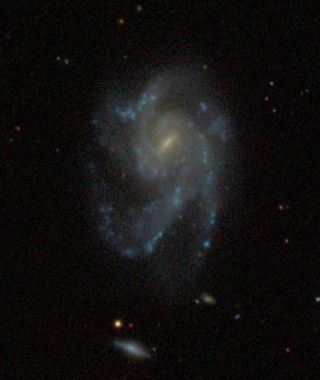
NGC 5579 is an intermediate spiral galaxy in the northern constellation of Boötes. It was discovered on May 1, 1785) by German-British astronomer William Herschel. The galaxy is located at a distance of 179 ± 14 million light-years (54.9 ± 4.3 Mpc) from the Milky Way, and is receding with a heliocentric radial velocity of 3,608 km/s. It is entry 69 in Halton Arp's Atlas of Peculiar Galaxies.
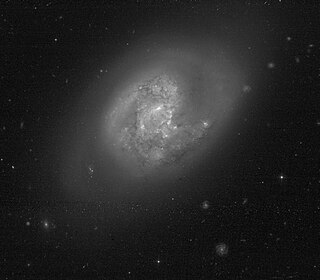
NGC 5665 is a spiral galaxy in the northern constellation of Boötes. It was discovered on January 30, 1784 by German-British astronomer William Herschel. This galaxy is located at a distance of 53.6 ± 7.7 million light-years (16.44 ± 2.37 Mpc), and is receding with a heliocentric radial velocity of 2,237 km/s. It is cataloged in Halton Arp's Atlas of Peculiar Galaxies as object number 49.

NGC 7714 is a spiral galaxy in the constellation Pisces. Its velocity with respect to the cosmic microwave background is 2430 ± 26 km/s, which corresponds to a Hubble distance of 116.9 ± 8.3 Mly (35.85 ± 2.54 Mpc). In addition, five non-redshift measurements give a distance of 92.24 ± 8.69 Mly (28.280 ± 2.664 Mpc). It was discovered by British astronomer John Herschel on 18 September 1830.

Arp 273 is a pair of interacting galaxies, 300 million light years away in the constellation Andromeda. It was first described in the Atlas of Peculiar Galaxies, compiled by Halton Arp in 1966. The larger of the spiral galaxies, known as UGC 1810, is about five times more massive than the smaller galaxy. It has a disc that is tidally distorted into a rose-like shape by the gravitational pull of the companion galaxy below it, known as UGC 1813. The smaller galaxy shows distinct signs of active star formation at its nucleus, and "it is thought that the smaller galaxy has actually passed through the larger one."

NGC 5566 is a barred spiral galaxy in the constellation Virgo, which is approximately 66 million light years away from Earth. The galaxy is the biggest in the constellation Virgo, stretching nearly 150,000 light years in diameter. The galaxy NGC 5566 was discovered on 30 April 1786 by the German-British astronomer William Herschel. It is included in Halton Arp's Atlas of Peculiar Galaxies. It is a member of the NGC 5566 Group of galaxies, itself one of the Virgo III Groups strung out to the east of the Virgo Supercluster of galaxies.

NGC 2857 is a spiral galaxy in the constellation Ursa Major. It was discovered on January 9, 1856, by R. J. Mitchell.

NGC 1169 is an intermediate barred spiral galaxy in the constellation of Perseus. NGC 1169 has a reddish center, indicating the region is dominated by older stars. In contrast, the outer ring contains larger blue-white stars, a sign of recent star formation. The entire galaxy is rotating at approximately 265 km/s.
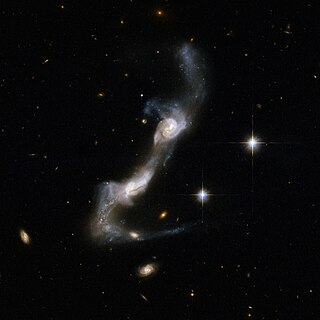
UGC 8335 is a pair of strongly interacting spiral galaxies. They have been distorted by extreme tidal forces, creating prominent tidal tails and a bridge of gas and stars between the galaxies.

NGC 2300 is a lenticular galaxy in the constellation Cepheus. Its velocity with respect to the cosmic microwave background is 1876 ± 7 km/s, which corresponds to a Hubble distance of 90.2 ± 6.3 Mly (27.67 ± 1.94 Mpc). However, 11 non redshift measurements give a distance of 131.98 ± 21.75 Mly (40.464 ± 6.668 Mpc). The galaxy was discovered in 1871 by French astronomer Alphonse Borrelly using an 18 cm telescope.
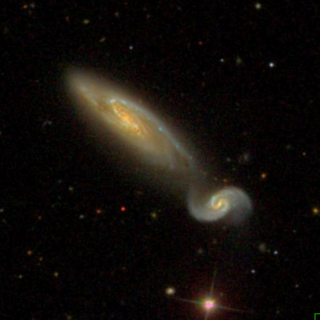
NGC 3800 is an intermediate spiral galaxy located in the constellation Leo. Its speed relative to the cosmic microwave background is 3,653 ± 24 km/s, which corresponds to a Hubble distance of 53.9 ± 3.8 Mpc. NGC 3800 was discovered by German-British astronomer William Herschel in 1784.

NGC 3799 is a barred spiral galaxy located in the constellation Leo. Its speed relative to the cosmic microwave background is 3,659 ± 24 km/s, which corresponds to a Hubble distance of 54.0 ± 3.8 Mpc. NGC 3799 was discovered by British astronomer John Herschel in 1832.
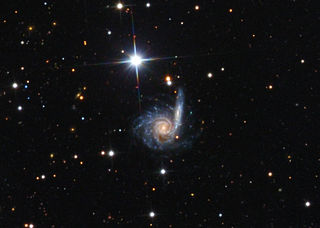
NGC 6365 is a pair of spiral galaxies in the constellation Draco. It consists of two galaxies, PGC 60174 to the south, and PGC 60171 to the north. These two galaxies are also designated respectively by the NASA/IPAC database as NGC 6365A and NGC 6365B. This pair of galaxies was discovered by German astronomer Lewis Swift in 1884.

NGC 3290 is a large and relatively distant intermediate spiral galaxy located in the constellation Hydra. Its speed relative to the cosmic microwave background is 10,937 ± 27 km/s, which corresponds to a Hubble distance of 161 ± 11 Mpc. NGC 3290 was discovered by American astronomer Francis Leavenworth in 1886.
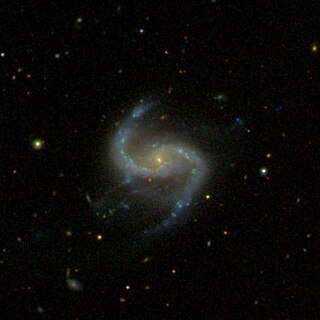
NGC 4017 is an intermediate spiral radio galaxy located in the constellation Coma Berenices. Its speed relative to the cosmic microwave background is 3,748 ± 21 km/s, which corresponds to a Hubble distance of 55.3 ± 3.9 Mpc. NGC 4017 was discovered by German-British astronomer William Herschel in 1785.

NGC 2937 is an elliptical galaxy located in the constellation Hydra. Its velocity relative to the cosmic microwave background is 105.1 ± 7.4 km/s, which corresponds to a Hubble distance of 105.1 ± 7.4 Mpc. NGC 2937 was discovered by German astronomer Albert Marth in 1864.

NGC 7253 is a pair of spiral galaxies in the constellation Pegasus. It was discovered by the German-British astronomer Albert Marth on 9 September 1863. It is listed in Halton Arp's Atlas of Peculiar Galaxies as Arp 278, as an example of gravitationally interacting galaxies.

NGC 5394 is a barred spiral galaxy located in the constellation Canes Venatici. Its speed relative to the cosmic microwave background is 3,639 ± 14 km/s, which corresponds to a Hubble distance of 53.7 ± 3.8 Mpc. NGC 5394 was discovered by German-British astronomer William Herschel in 1787.





















